NOVEMBER 24-26, 2022 : We spent the past three days in Chania, Crete. We arrived by plane on Thursday afternoon, spent Friday morning with a private tour guide, and then further explored the city on Shabbat.
Thursday morning, from our apartment in Athens, we took a taxi to the Athens airport. This trip, which took an hour, was longer than the flight to Crete, which takes only about 25 minutes. Once we were up in the air, the stewardesses quickly served water bottles and a snack, and before they finish serving everyone, the seat belt sign for landing was already turned on.
The Chania airport is one long building, similar to the original Ben Gurion airport in Israel. There are no sleeves to enter the building – you go down a staircase onto the tarmac and walk to the terminal. Just like for all flights years ago.
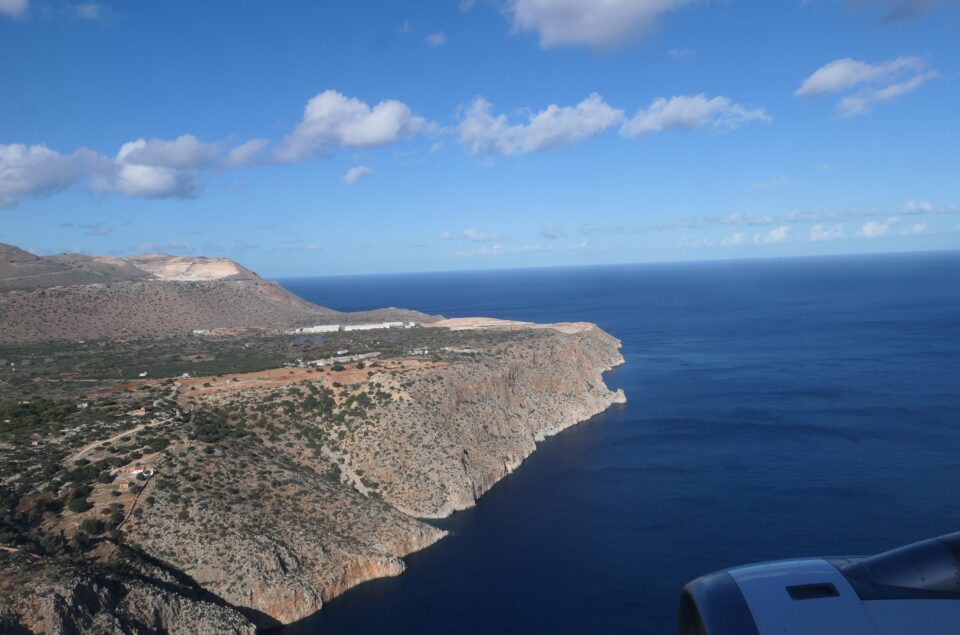
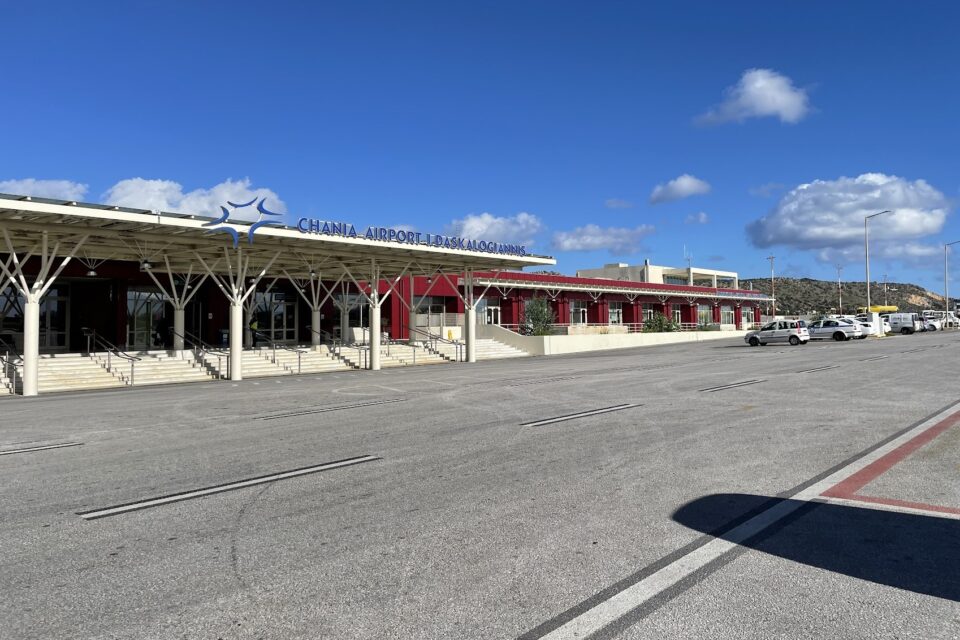
We quickly retrieved our suitcases and went to the taxi line. Our taxi driver would not let us take any luggage into the cab with us – he insisted that everything go into the trunk. We had three large suitcases, two carry-on trolleys and a big backpack which, of course, would not all fit easily into the trunk. He managed to get everything in – one on top of the other and then closed the trunk as far as it would go – which was about ½ way. He then secured everything with two bungee straps. The whole way to our apartment, I kept envisioning the trolleys falling out onto the road – especially when we drove up a hill. What would I do without my computer? Amazingly, we arrived at the apartment – after a long ½ hour ride – with all our luggage accounted for.
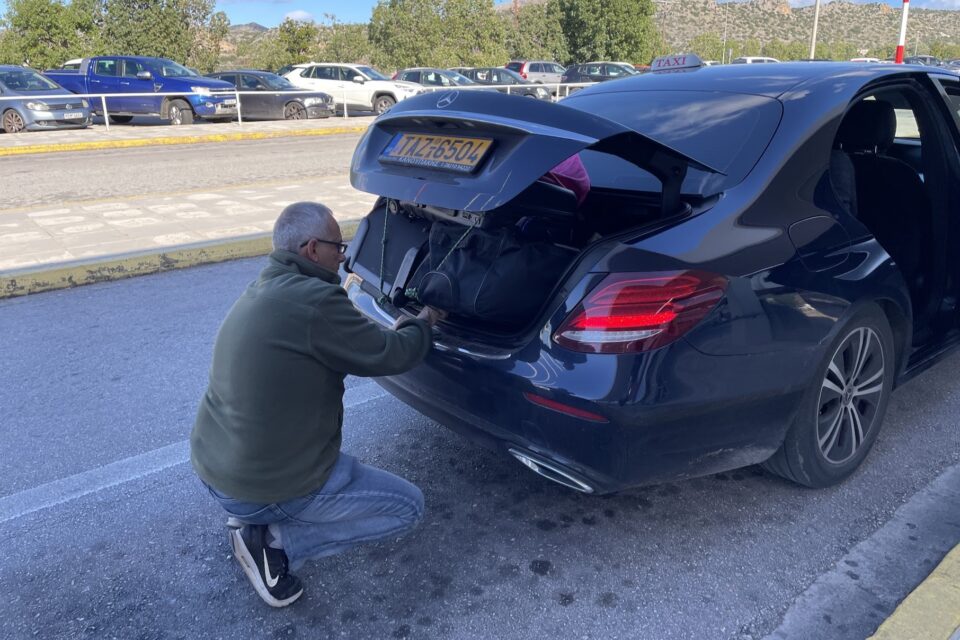
After settling in, we went for our first walk to discover Chania. Only a short block away from our apartment were the walls of the Old Town. We walked along the walls to the harbor. Chania was charming – pastel-colored houses and a deep blue sea. A beautiful lighthouse stands at the entrance to the harbor. The harbor front is mostly restaurants and tourist shops – only a few of them now open off-season.
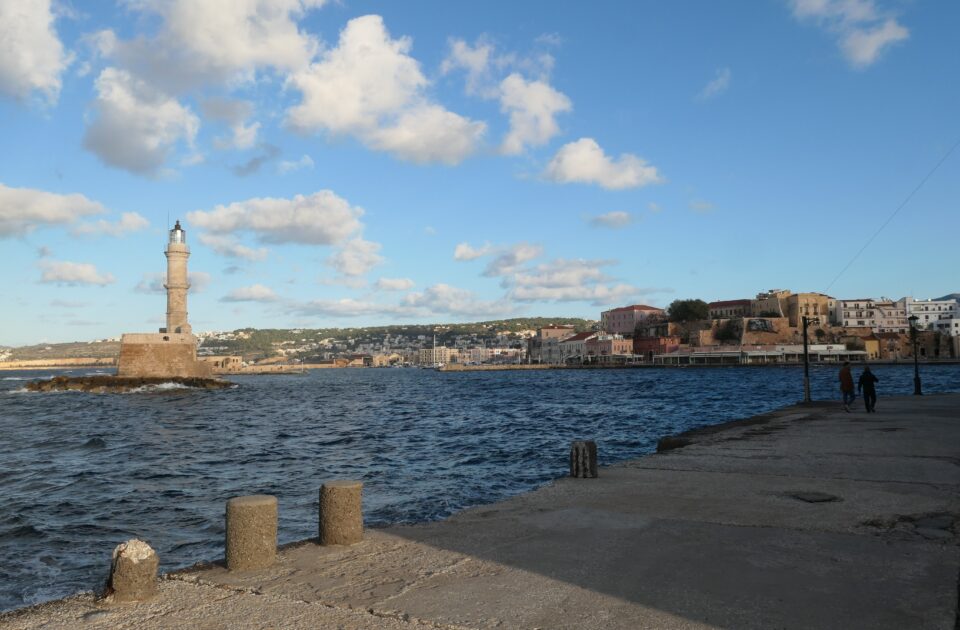
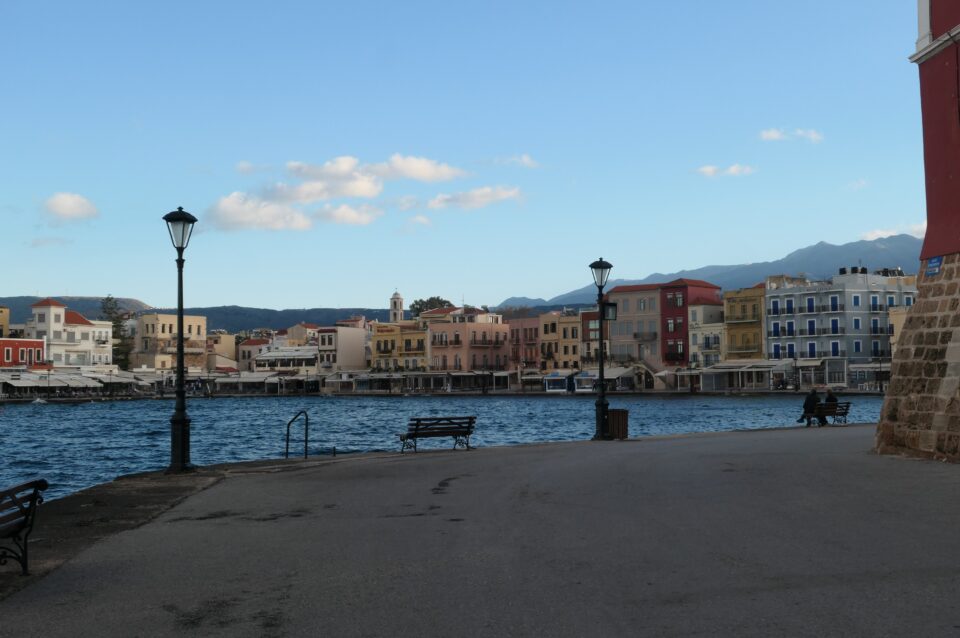
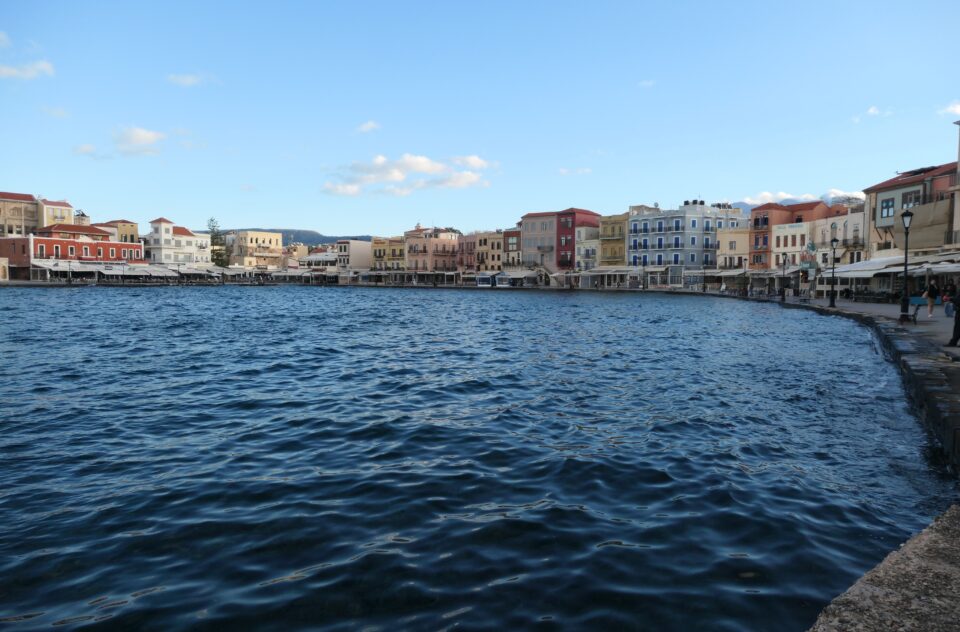
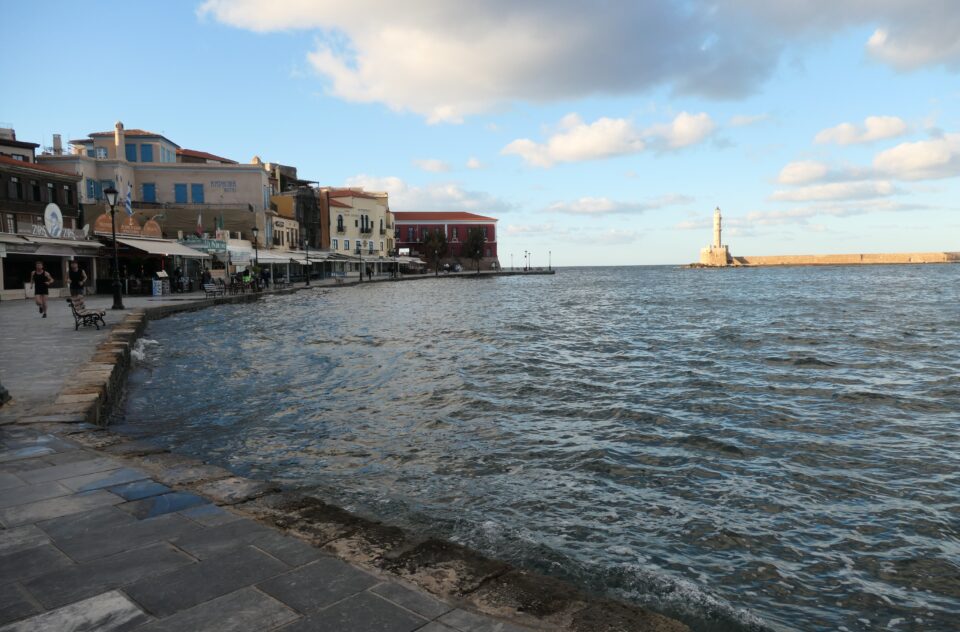
We then entered the alleyways of the Old Town and made our way to the synagogue. It was now closed, but the next day, on our Jewish Tour of the city, we would be sure to return.

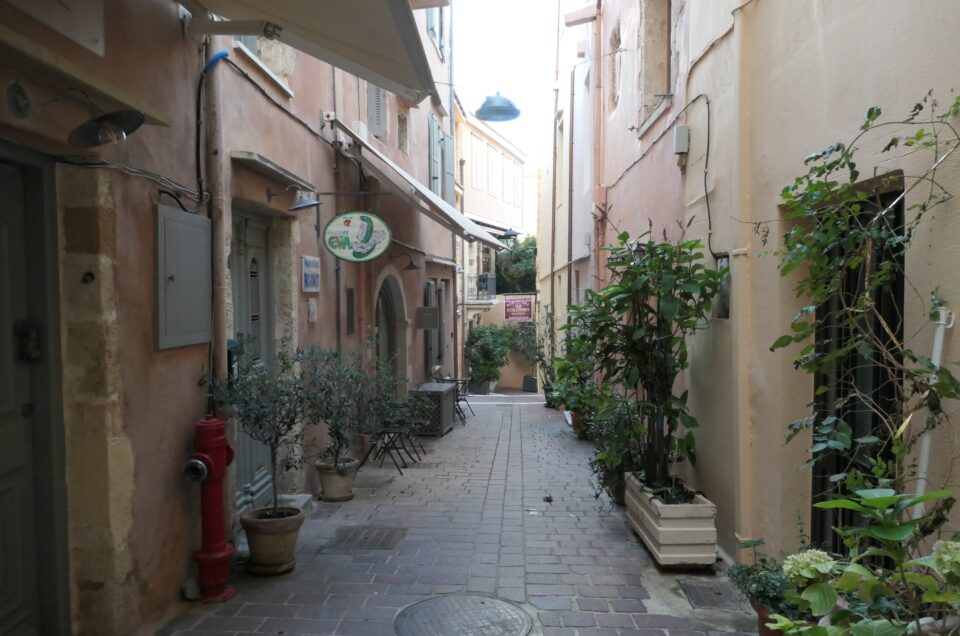
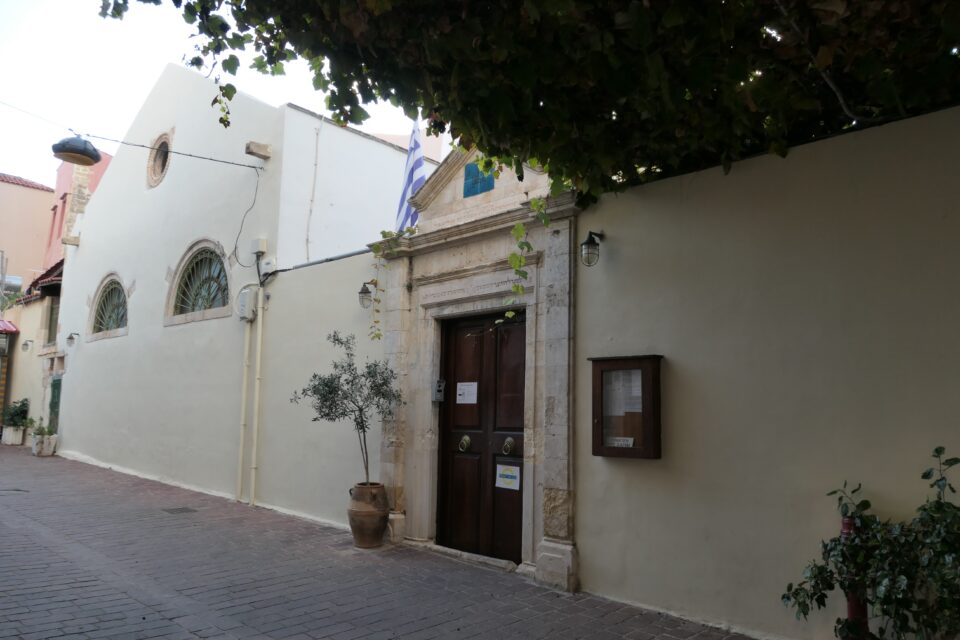
Our next destination was a vegan restaurant, but that too was closed for the off-season. There was one more vegan restaurant in the city. That was outside of the old town, and when we called, they were open.
We made our way outside the walled city. Inside the old town, everything felt sleepy. Here, outside the city walls, where the locals lived and shopped, the place was vibrant and full of people. All the stores were open and full. We easily located the vegan restaurant – a falafel shop. We had our dinner, stopped to do grocery shopping for Shabbat on the way home, and called it a day.

Friday morning, we met Tatiana, our guide right outside our apartment. Tatiana is an archeologist who takes an interest in the Jewish History of Crete. She was very knowledgeable, and we would spend the next few hours with her, wandering throughout the old city.
In short, Crete was home to the first great civilization developed in Europe. This was the Minoan civilization from about 3000 BCE. The Minoans lasted until about 1450 BCE. It is not clear why they were destroyed but one theory is that there was a large earthquake on a neighboring island, and the resulting tsunami wiped out their civilization. After the Minoans, came the Myceneans, indigenous Greek people, mostly from the Peloponnese peninsula. Crete thrived during these years of Greek civilization. This lasted until 67 CE when the Romans conquered Greece, including Crete. Next, in 395 CE, Crete became part of the Byzantine empire. In 1204, the Byzantines fell to the Crusaders, who immediately sold Crete to the Venetians. Crete prospered greatly during the next 425 years of Venetian rule. In 1669, the Turks took over and this started a time of stagnation on the island. In 1898, European powers convinced the Turks to give autonomous rule to Crete. This lasted until 1913, when Crete became part of Greece. During WW II, in 1941, the allies retreated to Crete as Germany quickly took over the Greek mainland. A large battle ensued, and the Germans remained in control until May 1945.
With this as a background, we then learned more as we visited various points around Chania.
Our first stop was the city walls at the end of our street, built by the Venetians in the 16th century. Chania was first enclosed by a Byzantine wall, which is still visible in some places today. The Venetians greatly enlarged the city when they built their wall.
Tatiana explained that the invention of gun powder and cannons caused a change in the design of the city’s fortifications. Previously walled cities had many watchtowers along the wall and small moats filled with water. Now, instead the fortifications were built with a large dry moat in front of them and bastions at every corner. The walls themselves became very thick – 10 meters thick in some places. The large dry moat ensured that they would see the enemy coming. Additionally, along the top of the wall was a curved protrusion that prevented using ladders to scale the wall. The thick walls were built to withstand cannon fire. The bastions, structures protruding outward from the walls at each corner, gave additional protection by providing a clear line of site to the whole wall.
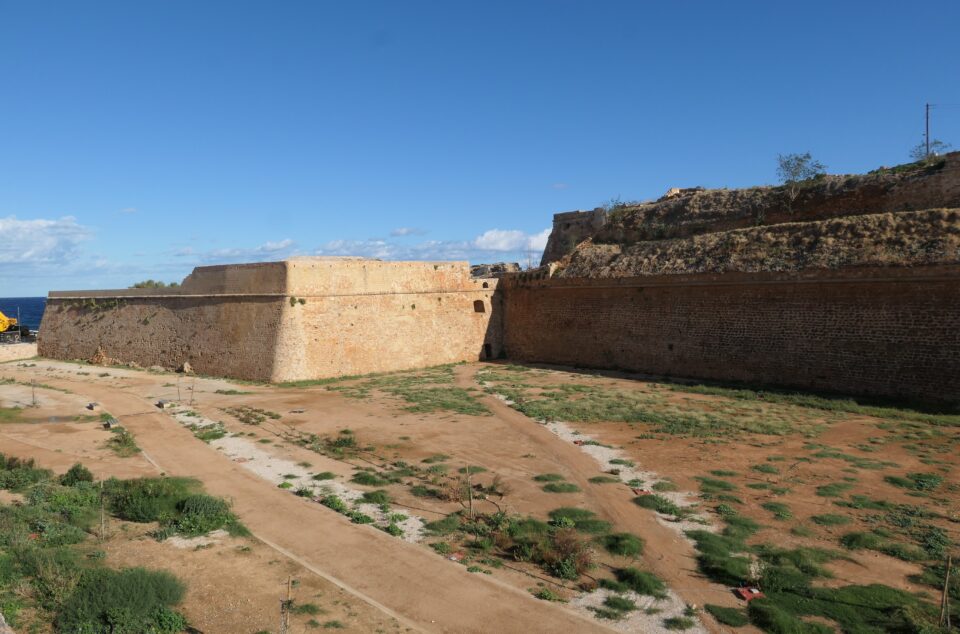
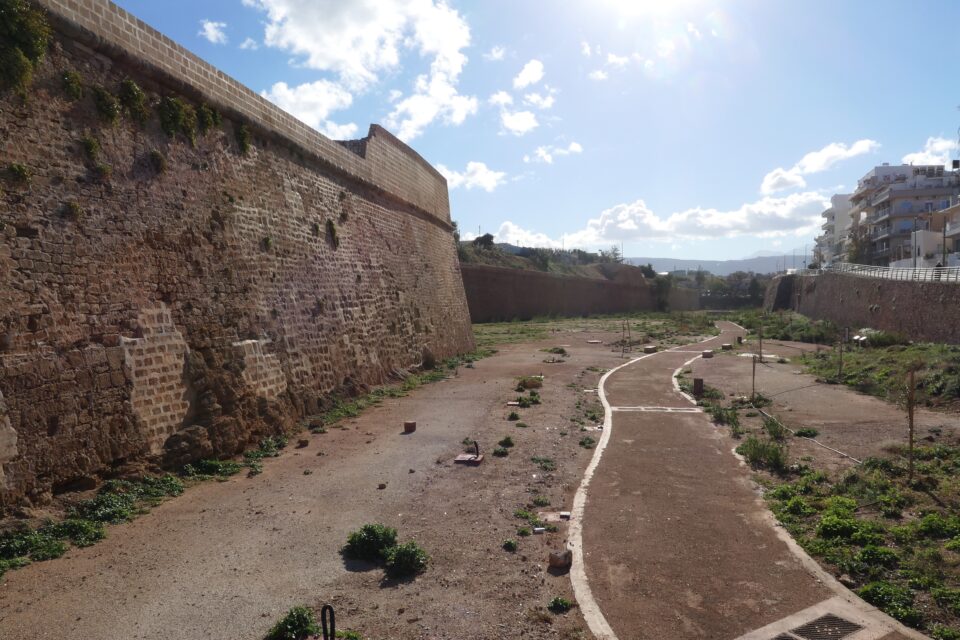
There are plans to turn the dry moat into a park, and we saw that this currently is a work-in-progress. Tatiana explained that public works happen very slowly in Chania. During the tourist season, the place is too busy and they cannot work. During off-season, they can work, but off-season is also the rainy season, and they can work only on dry days. Consequently, progress is very slow.
Our next stop was the courtyard of the Maritime Museum at the entrance to the harbor. The museum is housed in a fortress built by the Venetians and used as a garrison. The Ottomans later used it as a prison. It was in this courtyard that on the 1st of December in 1913, the Greek flag was raised signifying the unification of Crete with the rest of Greece. The raising of the flag was carried out by a 94-year old veteran of the revolt against the Turks in Crete, who had been imprisoned by them in the same compound.
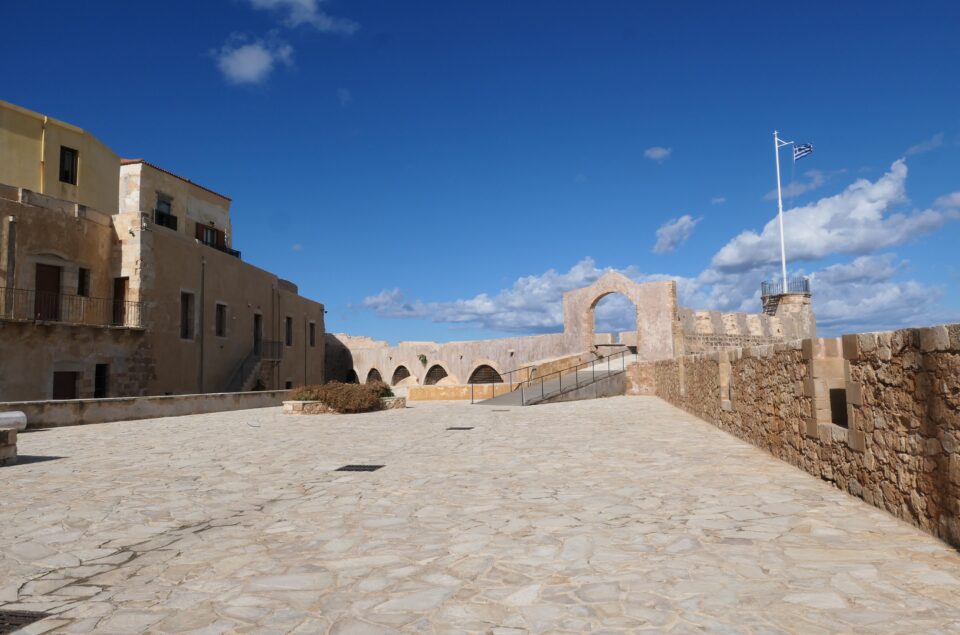
Not only did the Venetians extend the boundary of the city of Chania, they also enlarged the harbor, extending it to where the lighthouse stands today.
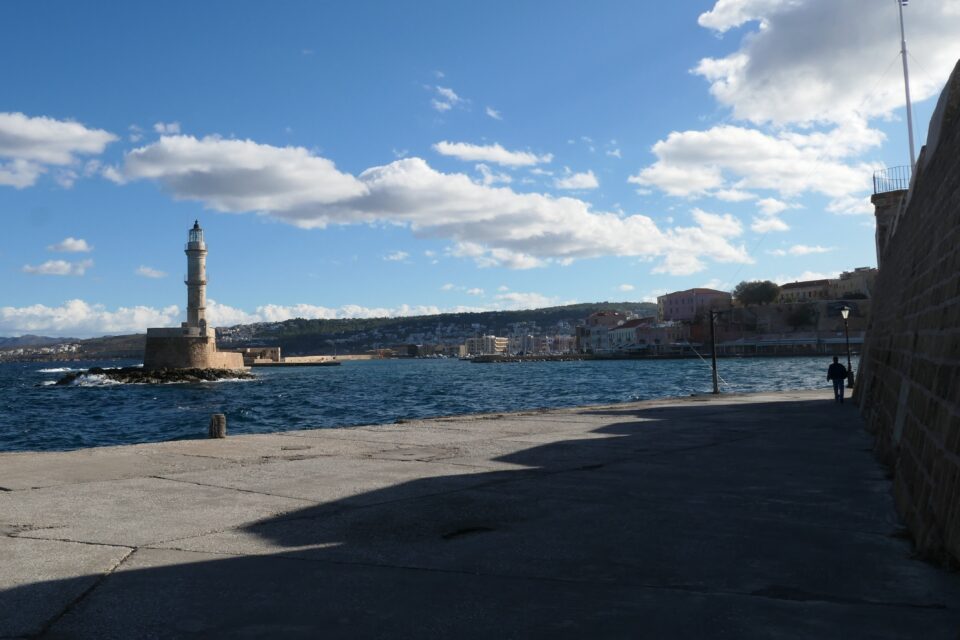
We then left the harbor and walked through the old city. Old town Chania has two different characters. On the eastern side of the old city, 85% of the buildings were destroyed during WW II. On the western side, much less so, such that the western side retains the old world charm, while the eastern side is much more modern. On the western side, many buildings preserve the original architecture – that is stone houses from the Venetian time that were expanded with upper floors and balconies in wood by the Ottomans.
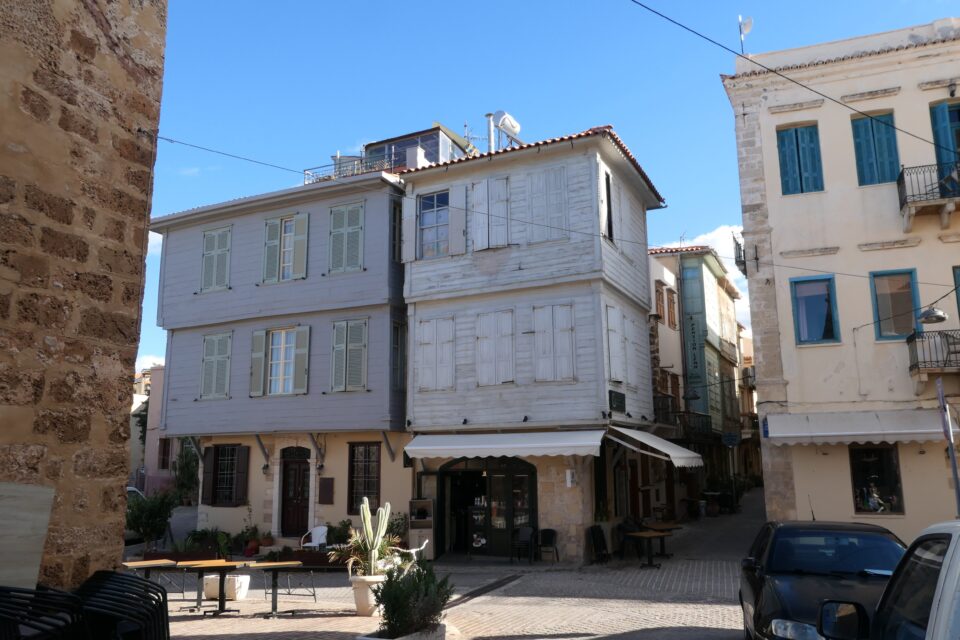
Our next stop was a tourist shop in the old city called Temple. This store is housed in a building that was once a small church during the Venetian era and then became a mosque when the Ottomans took over. In one corner you see the remains of a minaret. The store also has a glass floor showing empty Venetian graves below. These were discovered only three years ago when the owners dug below the store to install a new air-conditioning system. Most interestingly, in the corner of the store is an arched stand with two Jewish stars decorating the sides. It is thought that after the Moslems left Crete in the population exchange in 1923, the building became the residence of a Jewish family who added the decoration.
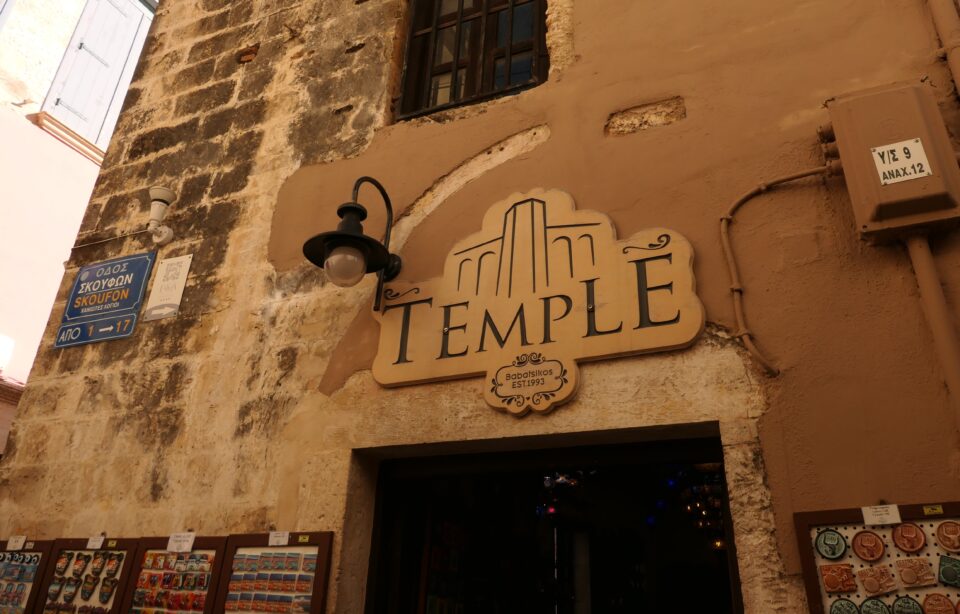
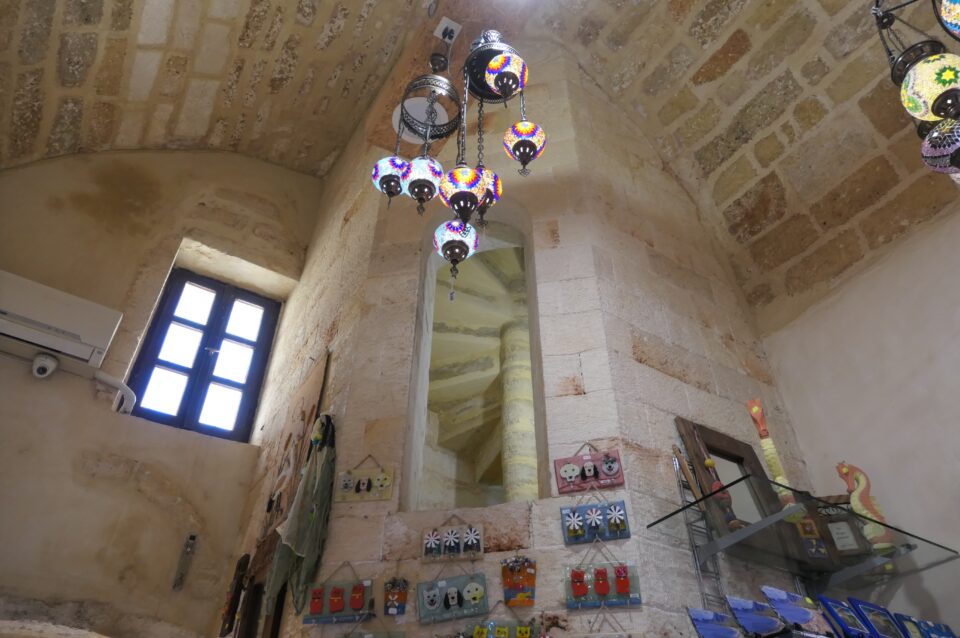
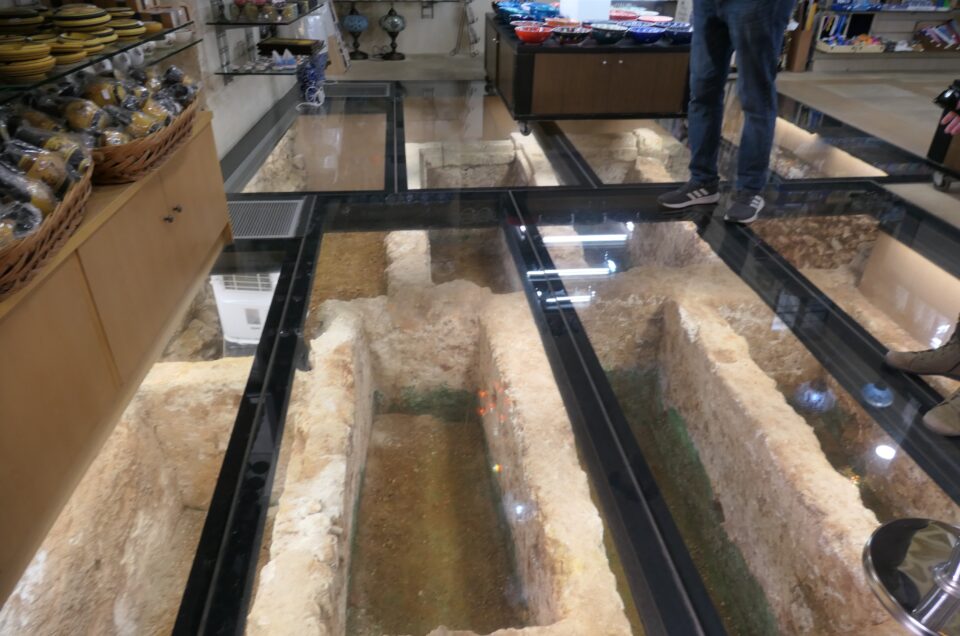
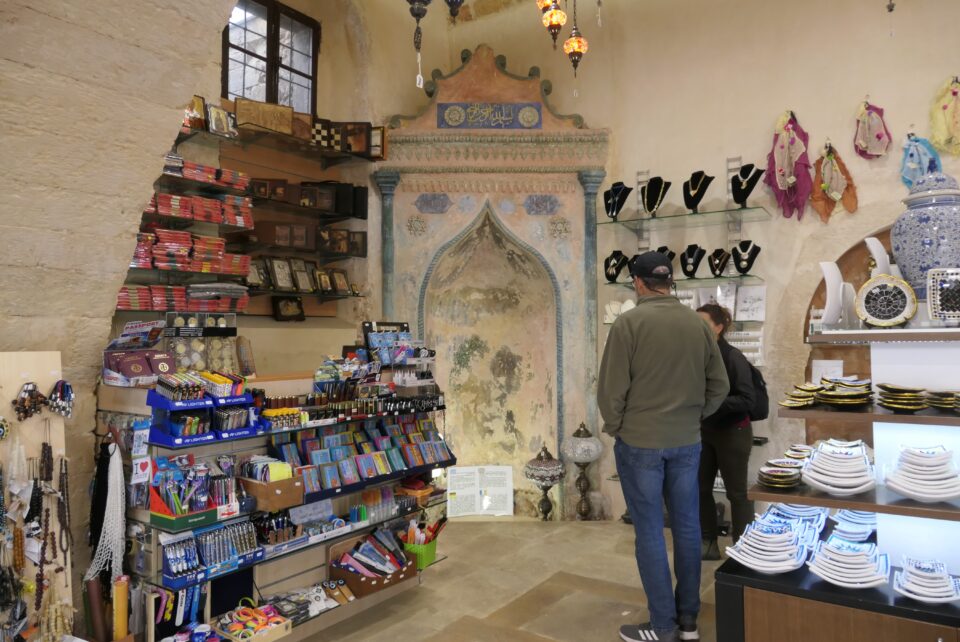
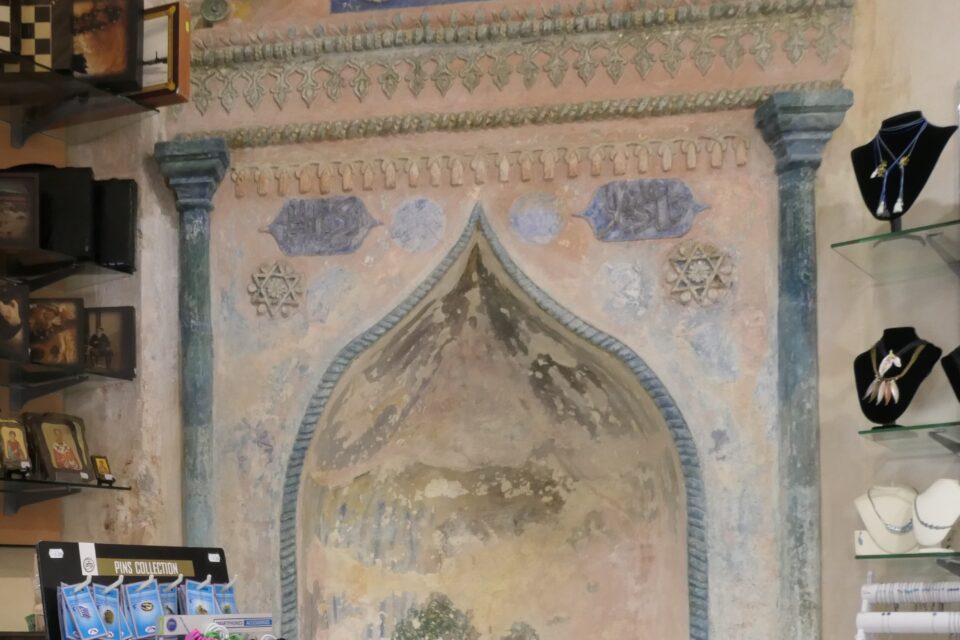
From this store, it was not far to the Jewish quarter of the old city. The story of the Jews of Crete is a particularly tragic one.
Jewish communities have existed in Crete since the 4th century BCE, thus making them one of the oldest diaspora communities in the eastern Mediterranean. When the Germans arrived in 1941, there were about 300 Jews in Crete and most of them lived in Chania. In Chania were two synagogues – the Sephardic Bet Shalom and the Romaniote Etz Haim. On May 20, 1944, the Jewish community was arrested and taken to a local prison for two weeks and then transported to Heraklion, where they boarded a German steamship, the Tanais. The Jews were on the ship together with Italian prisoners of war and arrested Cretan resistance fighters. The Tanais was bound for Athens where the Jews would then be transported by train to the death camps in Poland. However, the German steamship was not marked as a prisoner ship and was torpedoed by the British not long after departing Heraklion. The ship sank and almost everyone onboard was killed, including all the Jews. The entire community was extinguished, there were no survivors. Thus ended a Jewish presence on Crete that had lasted almost 2500 years. Today there are only about 10 Jews living in Crete and the only reminder of the island’s Jewish history, is the Etz Haim Synagogue.
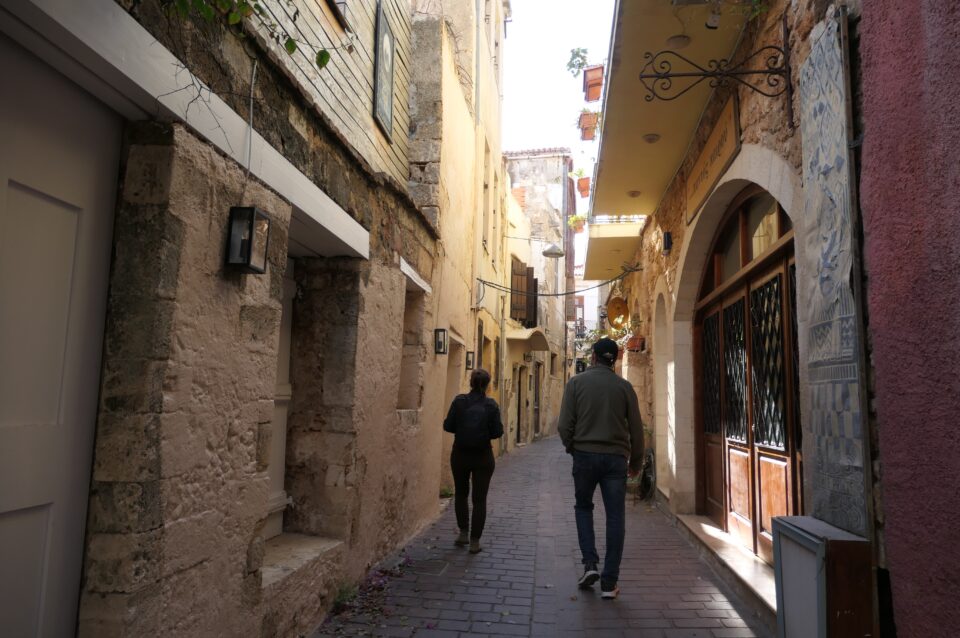
Etz Hayyim stood abandoned from WWII until the 1990s, when Hania resident Nikos Stavroulakis (an artist, art historian and founding director of the Jewish Museum of Greece in Athens) decided to rebuild and revive the synagogue. He started fund raising to restore Etz Haim which had been damaged in the war, but not totally destroyed. Stavroulakis managed to raise enough interest and funding to fully restore the synagogue in just a few short years. On October 10, 1999, the synagogue was officially rededicated.
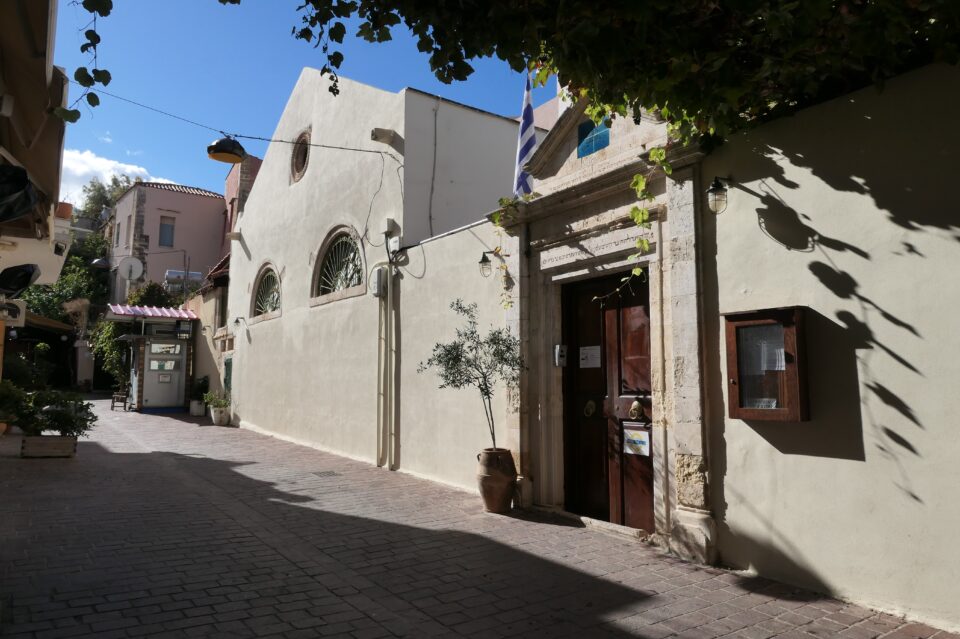
Today, Etz Hayyim synagogue is an active place of worship with a small multinational and multi-faith group called the “Havurah”. It also maintains a small research staff that is documenting the history of the Cretan Jewish community.
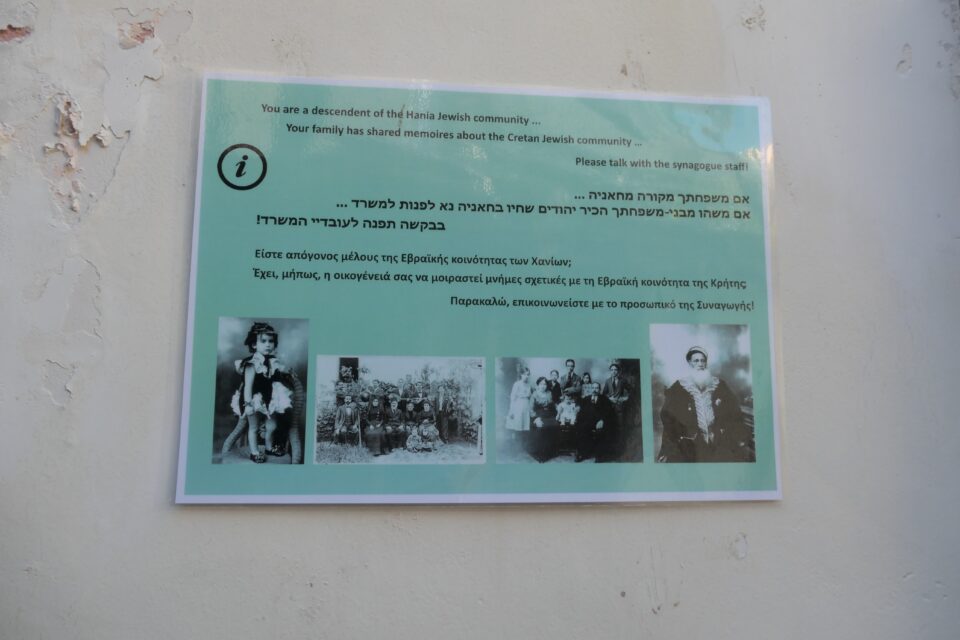
The synagogue is built in the typical Romaniote tradition – ark on one side, bimah another, chairs face the middle. There is a woman’s section upstairs that now houses an exhibit about the restoration of the synagogue. In the courtyard is the entrance to the mikvah, that still fills with sweet water- they are not sure from where the water is coming from. Also in the courtyard are several Hebrew tombstones brought there for safekeeping.
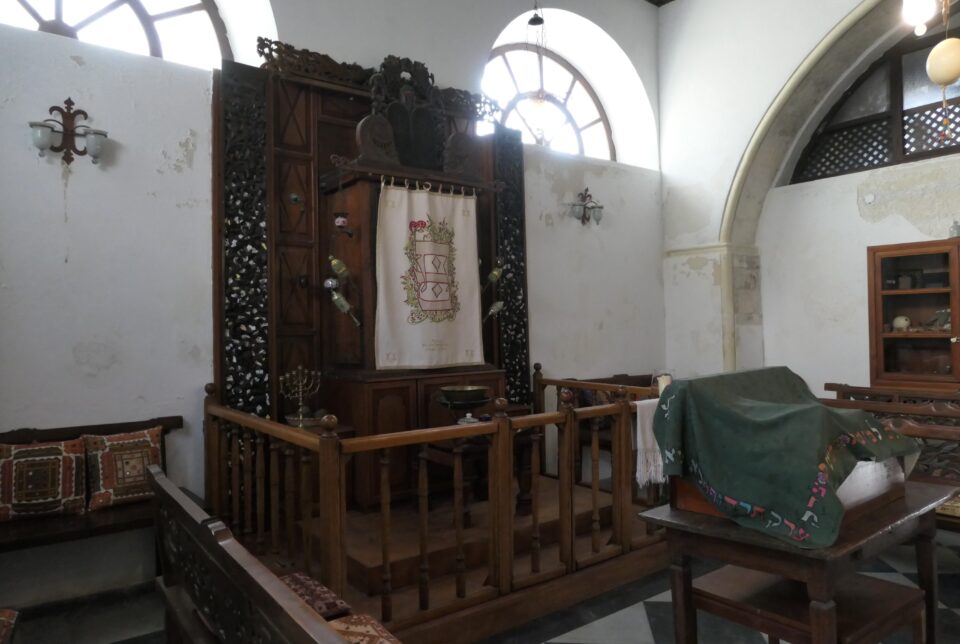
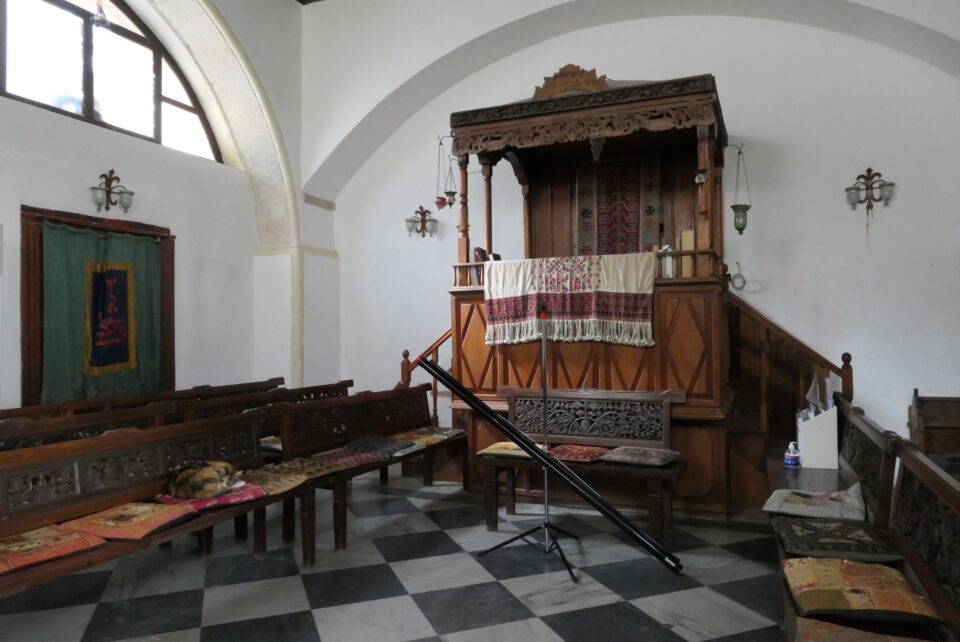

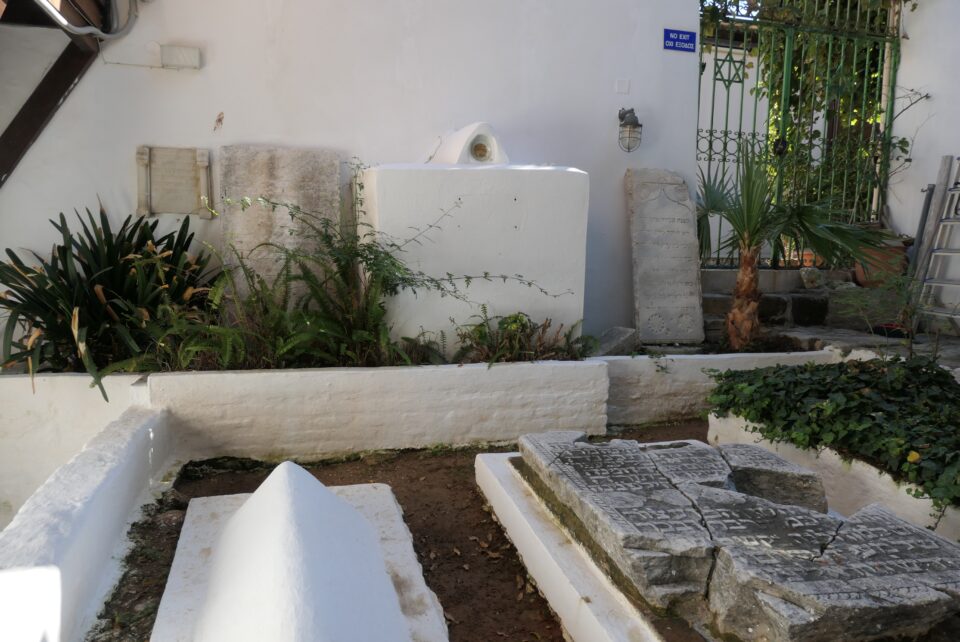
One of the unusual features of the synagogue is that the chandelier is decorated with ostrich eggs. There are different theories why this is so. One explanation is that a member of the congregation did trade with Africa and donated the eggs to the synagogue. Another is that they were deliberately placed there because it was thought that the eggs prevent spiders and mice from eating the oil in the lamps.
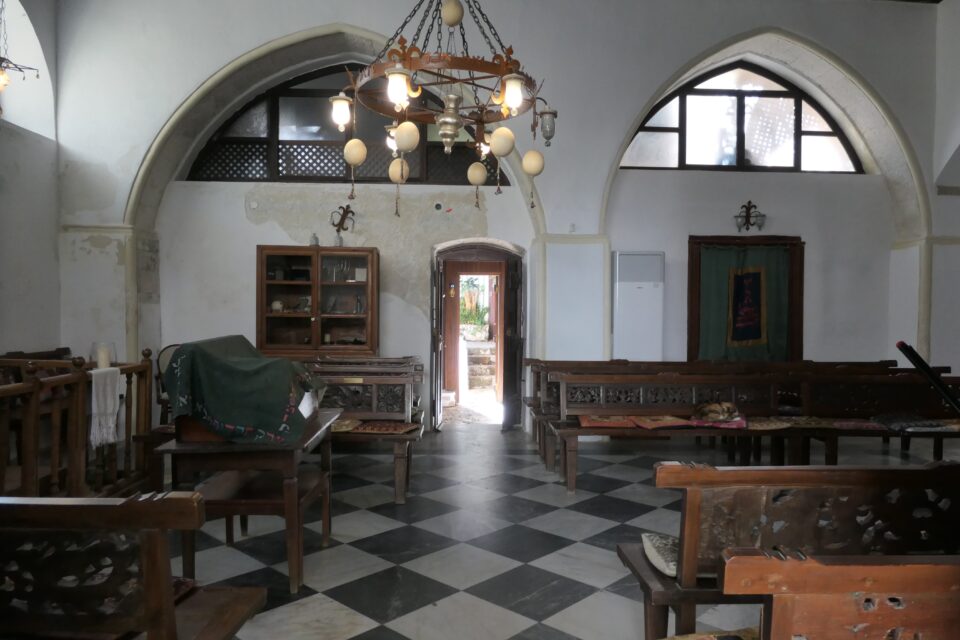
From the synagogue we crossed over to the eastern side of town. This was the part of town that was mostly destroyed during WWII. No longer were there the narrow alleyways and old houses. Here were streets wide enough for cars and homes that looked more modern. Every once in a while, scattered among the houses were archeological digs showing remains of the ancient Minoan civilization that once lived here.
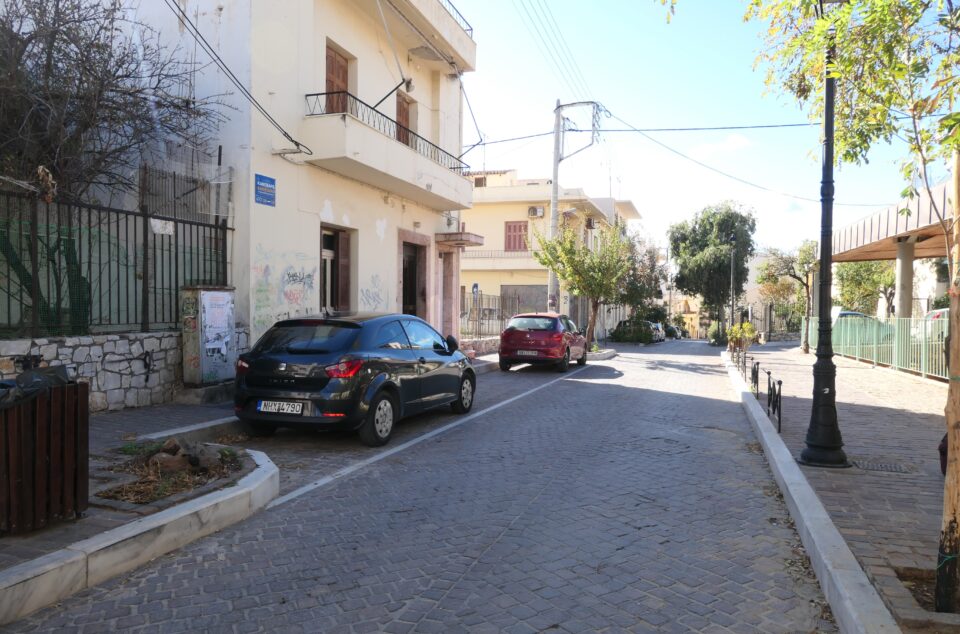
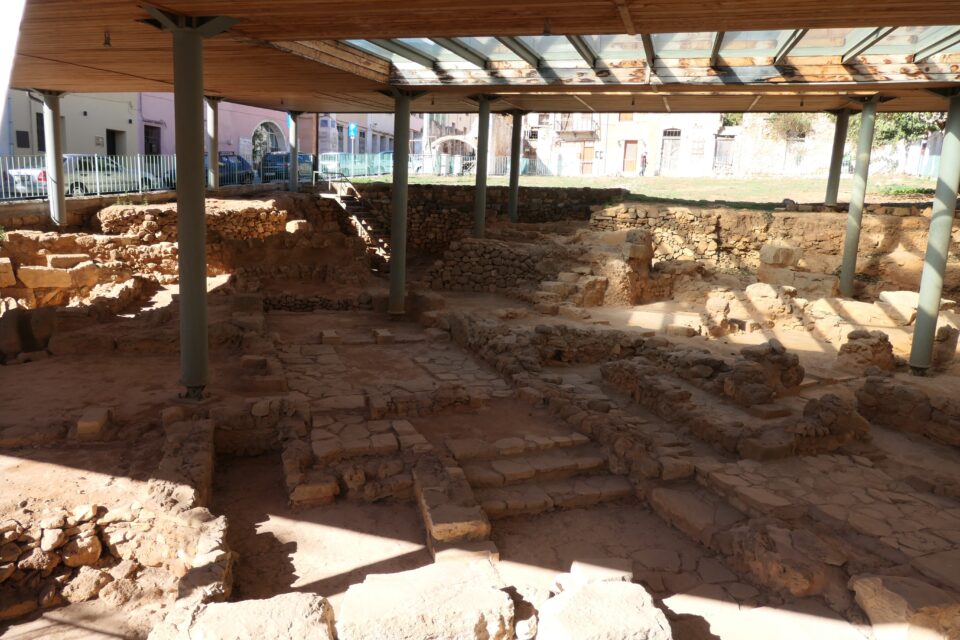
We then went to see the Church of Agios Nikolaos (St Nicholas). The building was originally a church built by the Venetians, but when the Turks came to Crete, it was converted into a mosque. Today it operates once again as a Greek Orthodox church complete with a bell tower but the minaret remains. It is the only building in Greece that has both a bell tower and minaret.
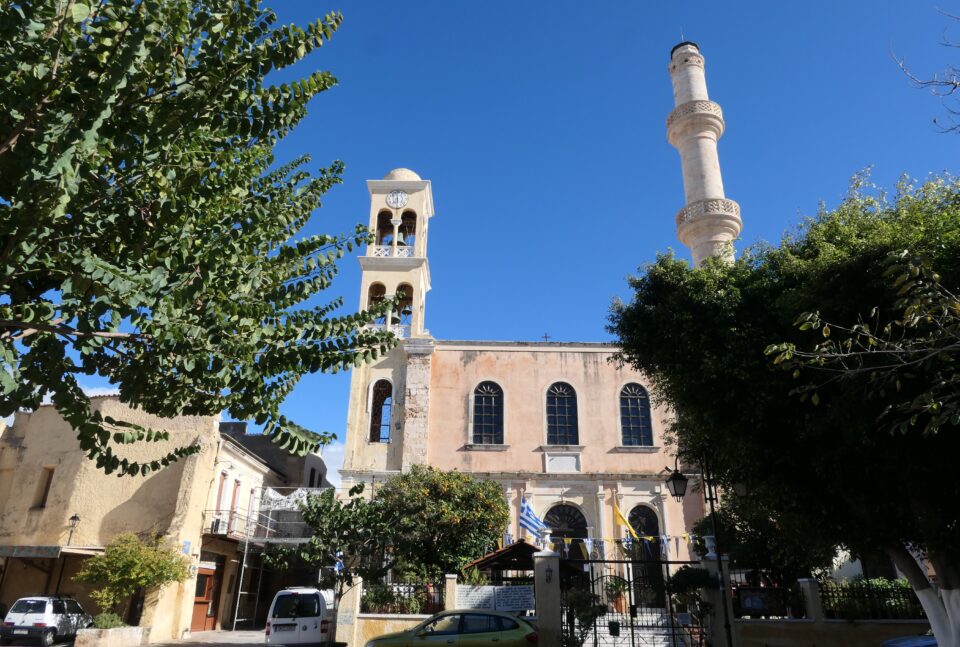
Being a winter Friday, with sundown coming early, we said our good-byes to Tatiana and made our way back to the apartment to prepare for Shabbat.
Mark then returned to the Etz Haim synagogue for Friday night services. There were 12 people there, mostly tourists. Three local people are responsible for the shul and lead the services. Everyone in the room is invited to light Shabbat candles at the synagogue, including the men. Men and women sit together. The three people who could read Hebrew (two locals and Mark) took turns reciting the prayers. Mark was also asked to read the English translation of one of the prayers. This prayers usually ends with the blessing “May G-d spread his canopy of peace upon us and all of Israel and Jerusalem.”. However, the translation that they gave Mark to read had an additional phrase “and the Ishmaelites”. This was to honor the Muslims who participated in the rebuilding of the community and the synagogue.
On Saturday mornings, the synagogue does not hold services, so Mark said Shabbat morning prayers in our apartment while I worked on my blogs. When he was finished, we had kiddush and then left the apartment to walk beyond the old town, to the other side of the city, in search of a monument in remembrance of the SS Tanais – the ship the carried away the Jews of Crete and was torpedoed.
Once again we walked along the city walls to the harbor. This time we went all the way to the lighthouse, enjoying the sunshine and the beautiful views.
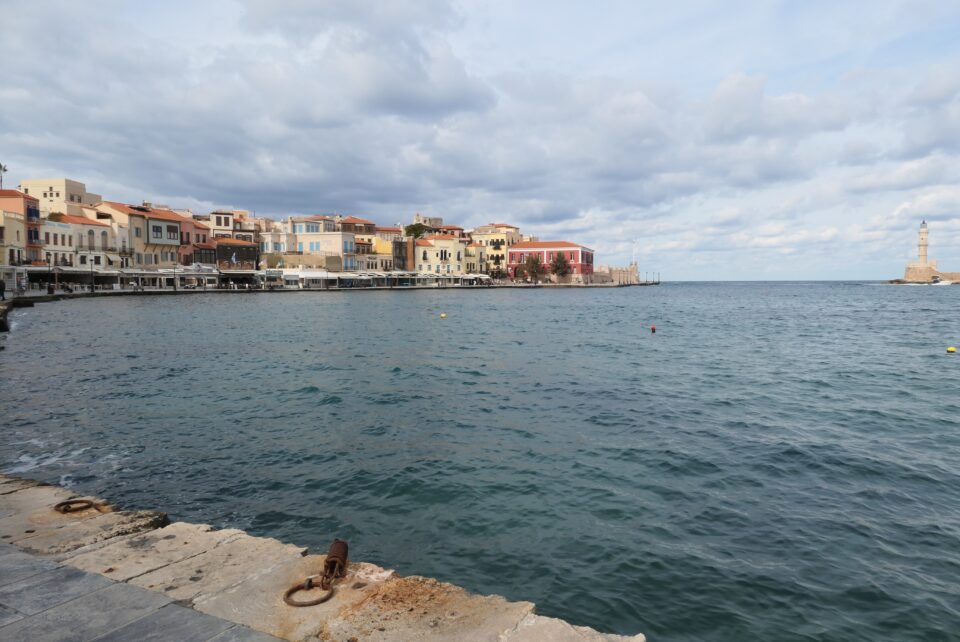
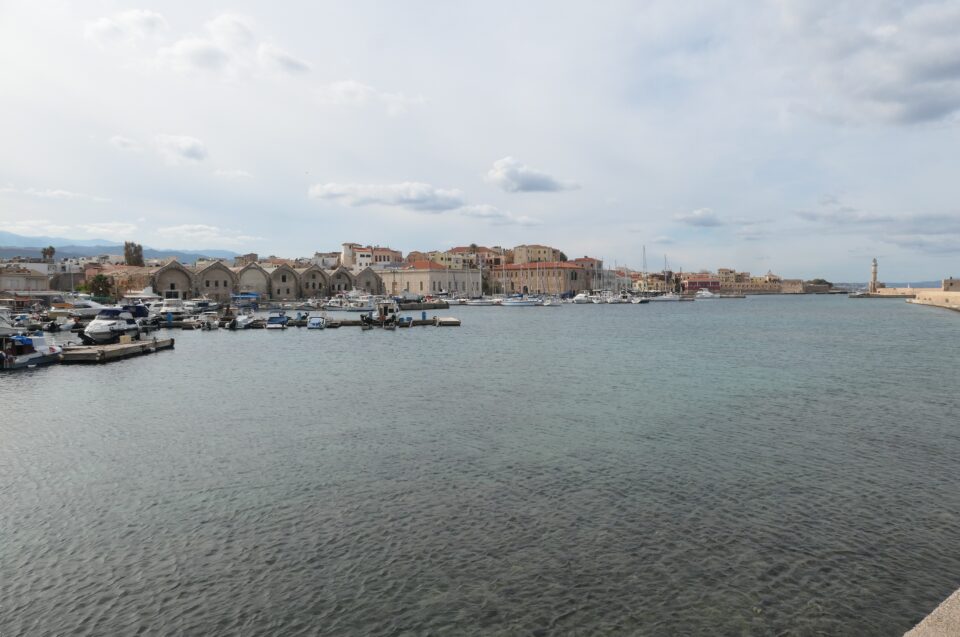

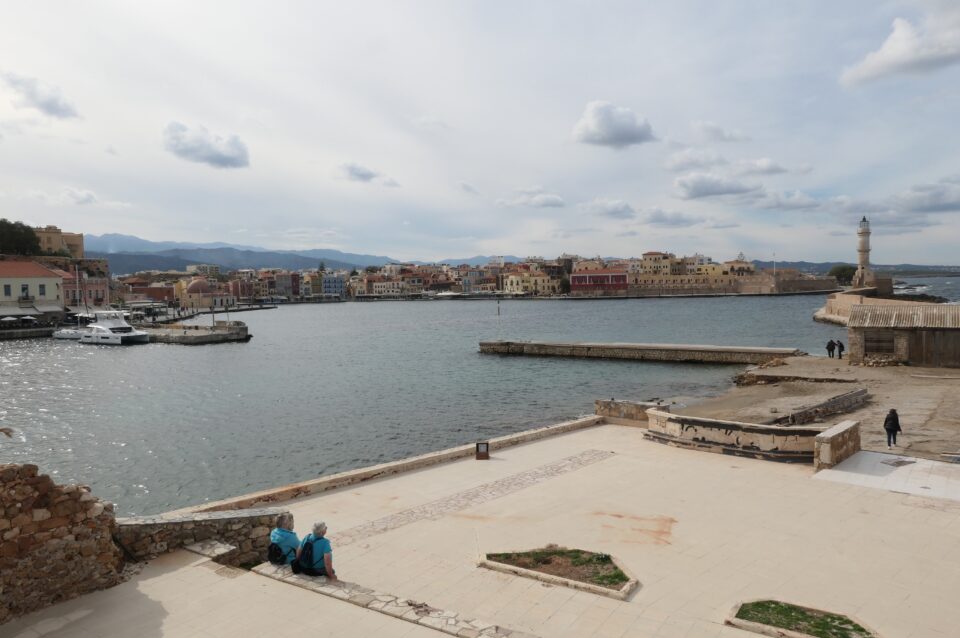
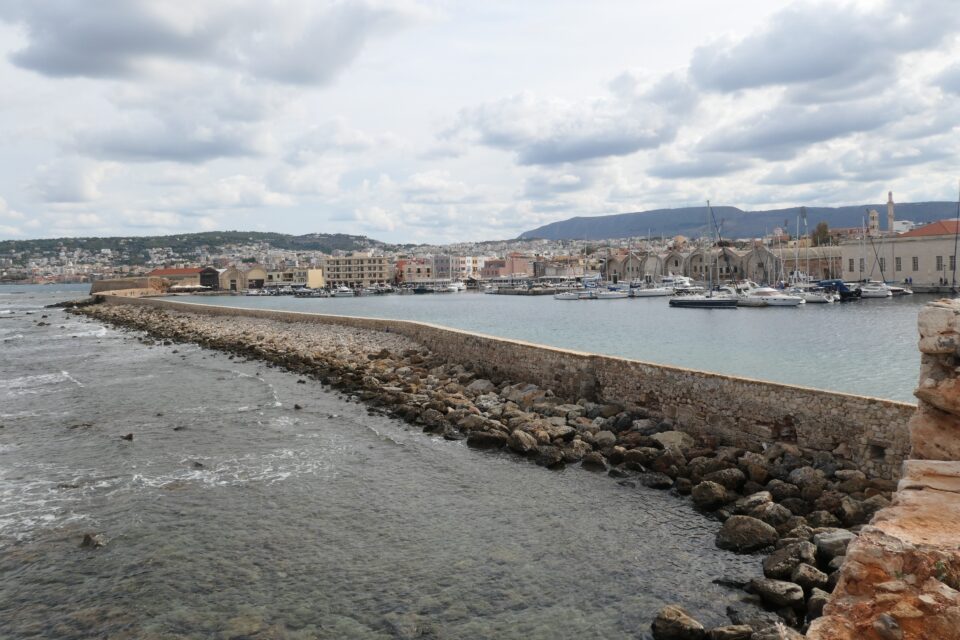


From the lighthouse, we walked through the eastern part of the old town and exited on the eastern side. The monument was easy to find. The monument, dedicated on October 14, 2012, resembles a ship and the doves above symbolize those who were killed there. Near the monument is a small plaque that reads “In memory of the Greek Jews of Crete, men, women and children, of the Christian members of the resistance, of the Italian antifascist servicemen who died tragically in the sinking of SS Tanais on June 9th 1944 during World War II.” Every summer, there is a memorial service for the victims held at this monument.

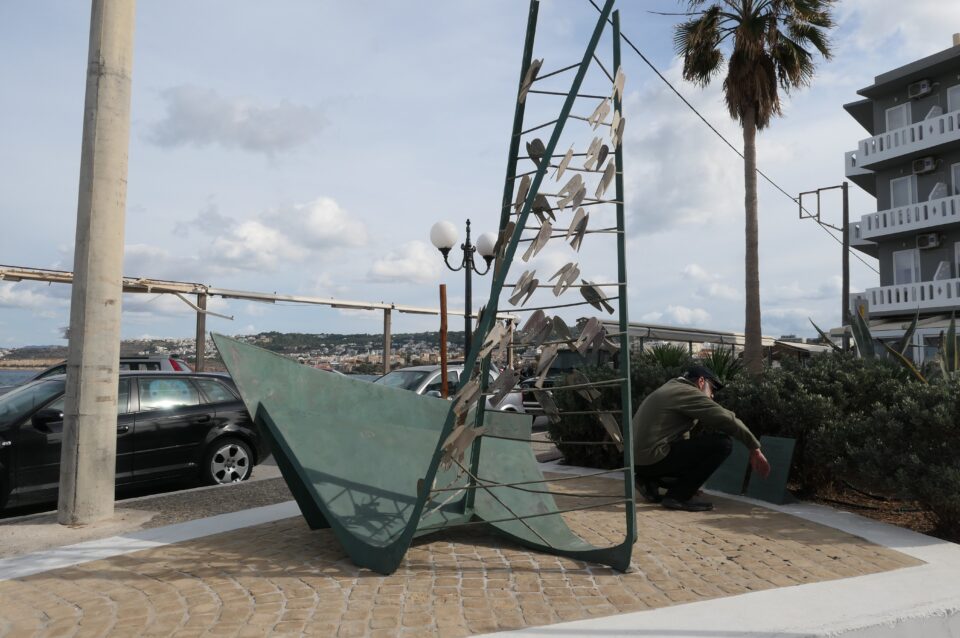
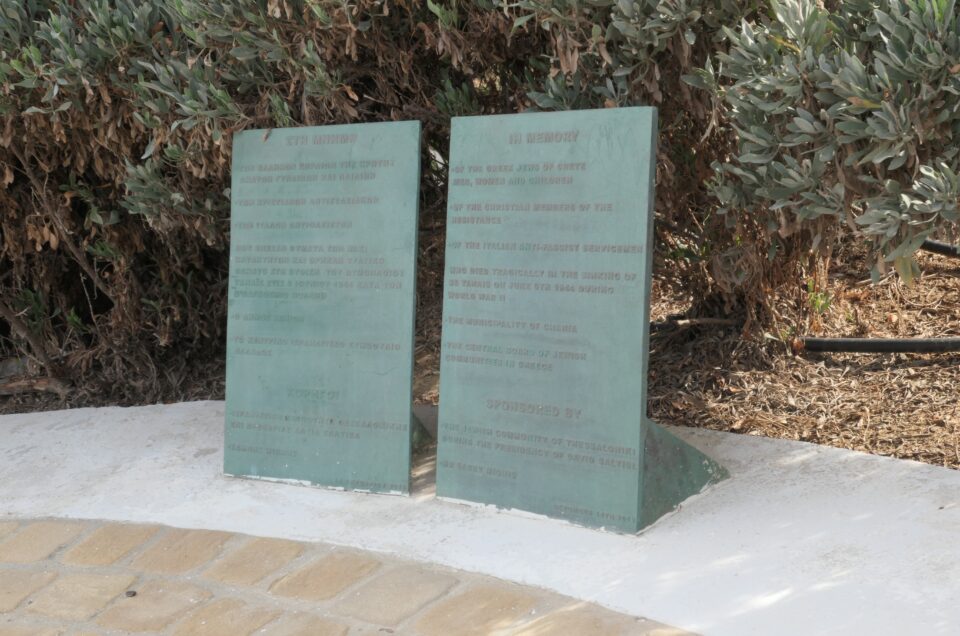
Although it is good that such a monument exists, this memorial is very easy to overlook. The explanatory plaque is a bit hidden sitting low among bushes. In contrast, near our apartment was an additional monument that commemorates the sinking of the SS Heraklion ferry in 1966 during extreme weather conditions. The memorial is known as “The Monument of the Hand”. It features a bronze hand reaching up to the sky against a background of some angled metal shapes representing the bow of a ship sinking beneath the waves. This monument is hard to ignore, and does a much better job of being noticed.

Leaving the SS Tanais monument, we came upon a large weekly outdoor market. Aside from the the usual fruits and vegetable stands, there were several venders selling olives, cheeses, honey, chestnuts and other local produce.


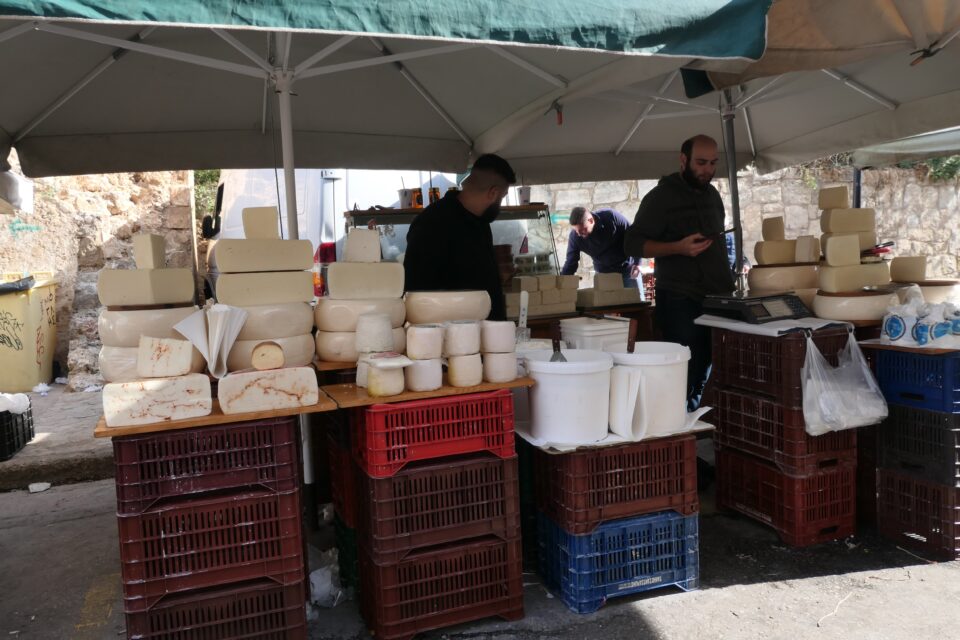
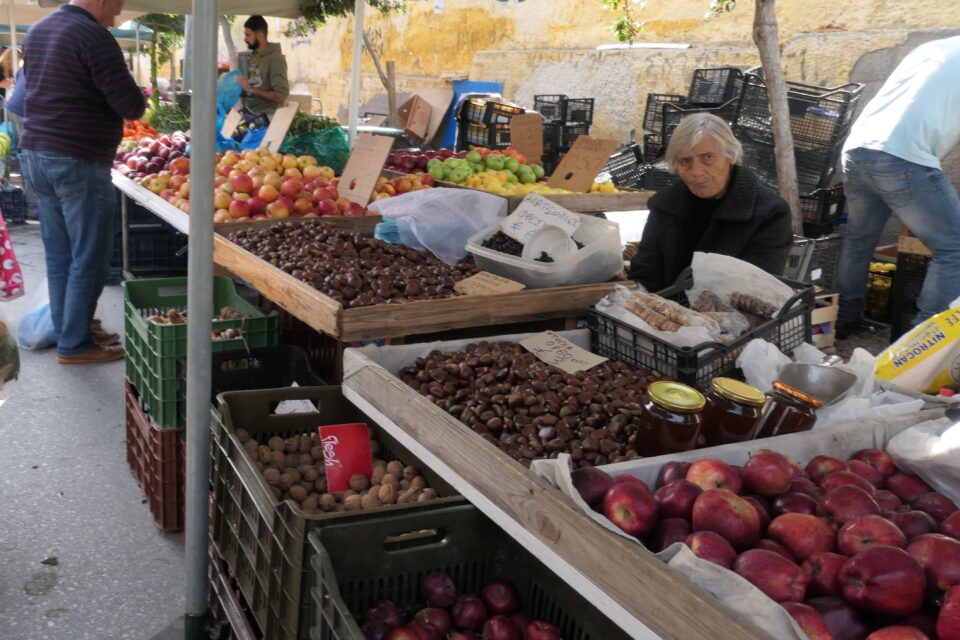
We continued our meandering in and out of the streets of old town. It was then time to return to our apartment for a late lunch and Shabbat naps. In the evening, Mark returned to several places we had visited in the city to verify their GPS location for our Wandering Jew app.
There was one more site in Chania that was on our list that we had not yet seen – the Archaeological Museum of Chania. According to my research, it has some Jewish tombstones on display. We will hopefully have a chance to visit there before we leave the city on Monday.
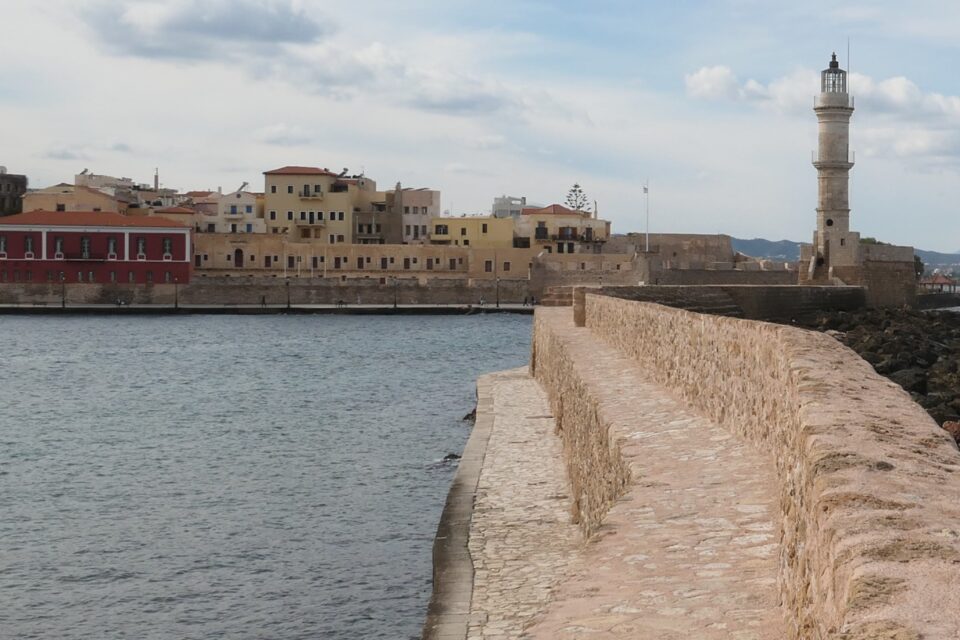
We had a beautiful time in Chania.